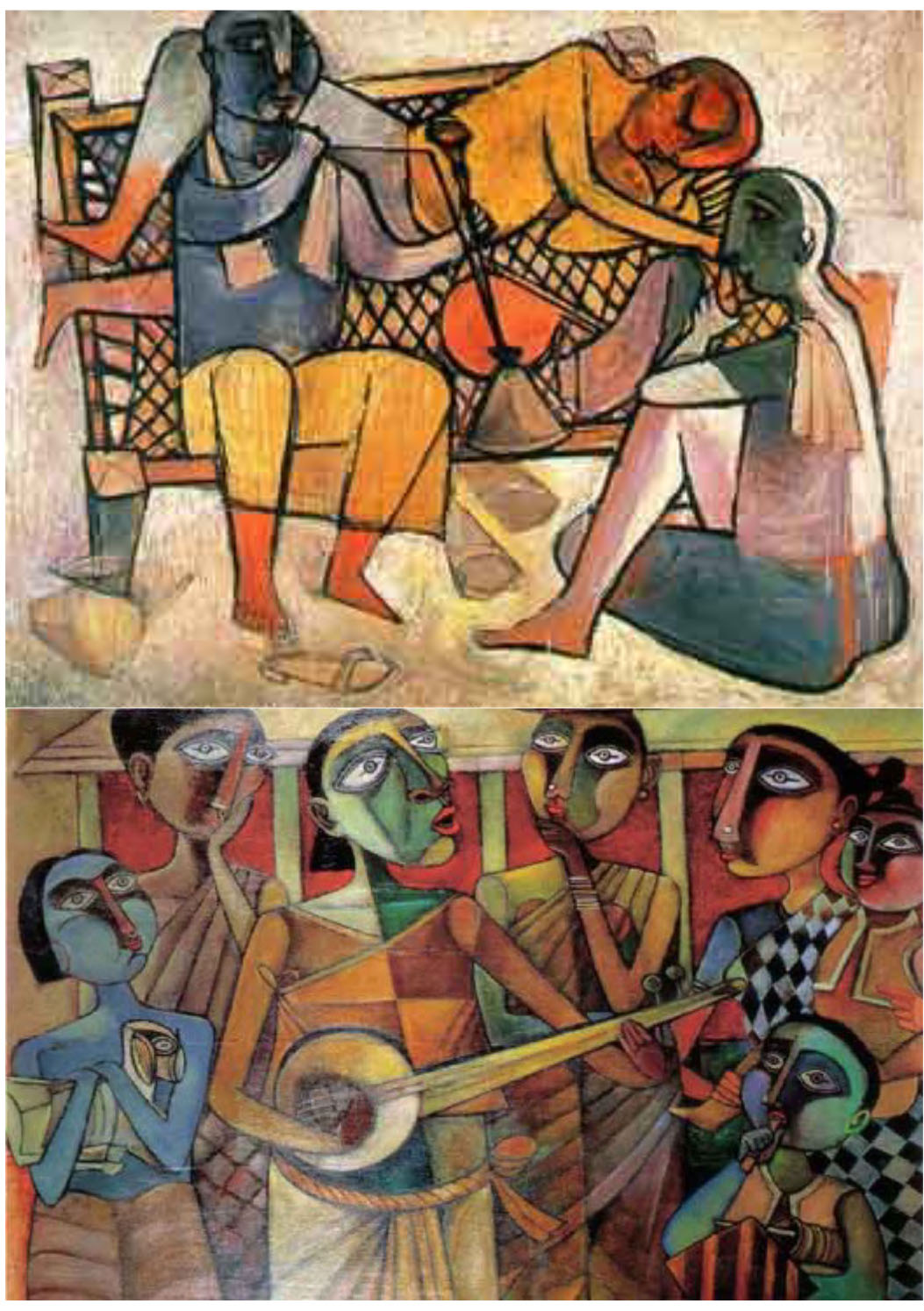Biography
A distinguished artist who established himself in the 1940’s, Paritosh Sen was born in 1919 in Dacca district,
now in Bangladesh. There has been some confusion as in records, it shows 1918 as his year of birth but the
artist himself has reason to believe it to be 1919. His father was a practicing Ayurvedic physician and twice
married with many children. He spent his early days ins such a big joint family, comprising his elder
brother’s and sister’s families, besides many other relatives. He had no meaningful sense of identification with
this family. Rather a sort of alienation had overshadowed his boyhood. He did not find any source of pleasure
in familial relationships or culture. No signs had there been in the house of any artistic activities except a few
bright colored dolls and a few photographs of gods and goddesses, bound in cardboard. Says he, “In a word,
the routine domestic life of Sen family had turned out to be quite dull and insipid save during marriage
ceremonies or puja festivals. This dullness makes me so restless at times". This mental vacuum had ruffled his
childhood days. Simultaneously, in him had slowly grown a sense of beauty too from his childhood. And it is
in this innate sense that had made him feel enchanted and enthralled by others in his neighborhood - from the
aesthetic sartorial skill of the tailor Hafez Mian, the painting skill of scene painter Jiten Gosai, the talent of
fabricating imaginative stories by the dentist Akhtar Mian to the enormous Arjuna tree in his village
stimulated Paritosh’s imagination in strange ways. The humanism of a low caste woman, her sense of duty
and devotion to work too earned his deep respect. This psychological contradiction which might be
conveniently termed as ‘Beltali-Zindabahar antinomy’ has shaped his sense of relaism and that un turn gas
served as the edifice of his art. It was his love for and awareness of his own local that his painting had its
genesis. In his search for style he embarked on his journey across the world, absorbing western modernism in
the process and synthesizing it with the native tradition. In his own unique style that he envisaged, in its
content and structure, has been reflected the essence of his locale in diverse, pulsating channels, to unfold the
‘local’ in multi-layers through the structuralism of ‘the global’, to analyze ‘the national’ in the light of ‘the
international’.
At his time, the art scene in India particularly in Bengal was becoming increasingly restive and eventful.
Despite a wide array of art schools in Bengal, Paritosh ran away at the age of 17 from home to study in
Madras Art School. Indian art as a whole , during the volatile 1930’s and 40s played a major role in shaping
young Paritosh’s vision. Art as practiced in the four corners of India, then as well as in the years that followed,
was a picture of variety in unity though the unity was often missing to a large extent. His apprenticeship in
Madras Art School, under Debiprasad Roychowdhury, taught him the prevalent trends in Indian art. The
art of Paritosh Sen, from his art school period until the time of his departure for Paris in 1949, bears
testimony to this futile struggle for artistic supremacy between the ne0-Indian style pioneered by
Abanindranath and the Western Academic technique employed with Indian content.
Paritosh, at 22, was a founder member of a group of young
Bengal painters collectively known as Calcutta Group and
already a pioneer of modernity in Indian art. This group along
with the Progressive Artists Group in Bombay played a key
role in ushering Modernism into Indian Art. There was a
buzz in the air for the contemporary youth to sympathize with
the Communist ideals, more so among creative people. The
themes of human emotion and sympathy for the downtrodden
that recur in Paritosh Sen’s art can be traced back to his youth
though he spent most of it outside Bengal. He got a teaching
job in Indore soon after his graduation from Madras Art
School and held it until 1949, the year he left for England and
France. His association with Calcutta and the Calcutta
Group was interspersed with the time spent elsewhere and
played a crucial part in developing in him a critical faculty to
combine with his emotional bent of mind. Sen took part in the
first exhibition of the Calcutta Group held in 1935, along with
six others, and in all subsequent exhibitions in Calcutta, Delhi
and Bombay. After he returned to India, Paritosh survived on
teaching jobs that allowed him to stay in Calcutta, from 1956
onwards. A closer and more direct involvement with the city
developed, and only now could he witness the sufferings of the
poor from within. His palette became passionately
expressionistic with varying shades of raw umber and earthy
brown. Masses of colour laid on the canvas with the cruel abandon of palette knife replaced the linear
depiction of defined forms that resurfaced in his art at regular intervals. He had married in between and
visited Europe, USA, Egypt and Mexico many times.

A prolific writer, Sen has published many works in both Bengali and in English, including a series of
autobiographical vignettes titled 'Jindabahar Lane'. His works have been exhibited in India and
internationally, in Paris, London, Germany, Tokyo and in the US. Paritosh Sen passed away in October
2008.
Text Reference:
An excerpt from the book Paritosh Sen IXth Decade, Artworld The Fine Art Gallery published by Neovision
Publishers Pvt. Ltd in 2006
An excerpt from the book The Art and Life of Paritosh Sen, Galerie 88 in 2007